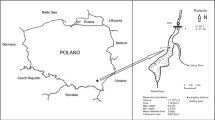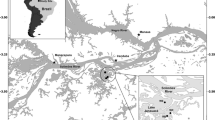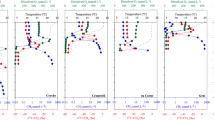Abstract
Methane emissions from aquatic environments depend on methane formation (MF) and methane oxidation (MO) rates. One important question is to what extent increased temperatures will affect the balance between MF and MO. We measured potential MF and MO rates simultaneously at 4, 10, 20 and 30°C in sediment from eight different lakes representing typical boreal and northern temperate lake types. Potential MF rates ranged between 0.002 and 3.99 μmol CH4 gd.w. −1 day−1, potential MO rates ranged from 0.01 to 0.39 CH4 gd.w. −1 day−1. The potential MF rates were sensitive to temperature and increased 10 to 100 fold over the temperature interval studied. MF also differed between lakes and was correlated to sediment water content, percent of organic material and C:N ratio. Potential MO did not depend on temperature or sediment characteristics but was instead well explained by MF rates at the in situ temperature. It implies that elevated temperatures will enhance MF rates which may cause increased methane release from sediments until MO increases as well, as a response to higher methane levels.




Similar content being viewed by others
References
Bartlett KB, Harriss RC (1993) Review and assessment of methane emissions from wetlands. Chemosphere 26:261–320
Bastviken D, Ejlertsson J, Tranvik L (2002) Measurement of methane oxidation in lakes: a comparison of methods. Environ Sci Technol 36:3354–3361
Bastviken D, Olsson M, Tranvik L (2003) Simultaneous measurements of organic carbon mineralization and bacterial production in oxic and anoxic lake sediments. Microb Ecol 46:73–82
Bastviken D, Cole J, Pace M, Tranvik L (2004) Methane emissions from lakes: dependence of lake characteristics, two regional assessments, and a global estimate. Global Biogeochem Cycles 18:GB4009. doi:4010.1029/2004GB002238
Bastviken D, Cole JJ, Pace ML, MC Van de Bogert (2008) Fates of methane from different lake habitats: connecting whole-lake budgets and CH4 emissions. J Geophys Res 113:G02024. doi:02010.01029/02007JG000608
Bender M, Conrad R (1994) Methane oxidation activity in various soils and freshwater sediments: occurrence, characteristics, vertical profiles, and distribution on grain size fractions. J Geophys Res 99. doi:10.1029/1094JD00266
Bender M, Conrad R (1995) Effect of CH4 concentrations and soil conditions on the induction of CH4 oxidation activity. Soil Biol Biochem 27:1517–1527
Benson BB, Krause D Jr (1984) The concentration and isotopic fractionation of oxygen dissolved in freshwater and seawater in equilibrium with the atmosphere. Limnol Oceanogr 29:620–632
Brazeau BJ, Lipscomb JD (2000) Kinetics and activation thermodynamics of methane monooxygenase compound Q formation and reaction with substrates. Biochemistry 39:13503–13515
Chin K-J, Conrad R (1995) Intermediary metabolism in methanogenic paddy soil and the influence of temperature. FEMS Microbiol Ecol 18:85–102
Crill PM, Harriss RC, Bartlett KB (1991) Methane fluxes from terrestrial wetland environments. In: Rogers JE, Whitman WB (eds) Microbial production and consumption of the greenhouse gases: methane, nitrogen oxides and halomethanes. American Society for Microbiology, Washington, pp 91–109
Dannenberg S, Wudler J, Conrad R (1997) Agitation of anoxic paddy soil slurries affects the performance of the methanogenic microbial community. FEMS Microbiol Ecol 22:257–263
Downing JA, Prairie YT, Cole JJ, Duarte CM, Tranvik LJ, Striegl RG, McDowell WH, Kortelainen P, Caraco NF, Melack JM, Middelburg JJ (2006) The global abundance and size distribution of lakes, ponds, and impoundments. Limnol Oceanogr 51:2388–2397
Dunfield P, Knowles R, Dumont R, Moore TR (1993) Methane production and consumption in temperate and subarctic peat soils: response to temperature and pH. Soil Biol Biochem 25:321–326
Forster P, Ramaswamy V, Artaxo P, Berntsen T, Betts R, Fahey DW, Haywood J, Lean J, Lowe DC, Myhre G, Nganga J, Prinn R, Raga G, Schulz M, Van Dorland R (2007) Changes in atmospheric constituents and in radiative forcing. In: Solomon S, Qin D, Manning M, Chen Z, Marquis M, Averyt KB, Tignor M, Miller HL (eds) Climate change 2007: the physical science basis. Contribution of working group I to the fourth assessment report of the intergovernmental panel on climate change. Cambridge University Press, Cambridge
Hulthe G, Hulth S, Hall POJ (1998) Effect of oxygen on degradation rate of refractory and labile organic matter in continental margin sediments. Geochim Cosmochim Acta 62:1319–1328
Huttunen JT, Väisänen TS, Hellsten SK, Martikainen PJ (2006) Methane fluxes at the sediment–water interface in some boreal lakes and reservoirs. Boreal Environ Res 11:27–34
Kelly CA, Chynoweth DP (1981) The contributions of temperature and of the input of organic matter in controlling rates of sediment methanogenesis. Limnol Oceanogr 26:891–897
Kiene RP (1991) Production and consumption of methane in aquatic systems. In: Rogers JE, Whitman WB (eds) Microbial production and consumption of greenhouse gases: methane, nitrogen oxides, and halomethanes. American Society for Microbiology, Washington, pp 111–145
King GM (1992) Ecological aspects of methane consumption, a key determinant of global methane dynamics. Adv Microb Ecol 12:431–468
King GM (1994) Associations of methanotrophs with the roots and rhizomes of aquatic vegetation. Appl Environ Microbiol 60:3220–3227
King GM (1997) Responses of atmospheric methane consumption by soils to global climate change. Glob Chang Biol 3:351–362
Knief C, Dunfield PF (2005) Response and adaptation of different methanotrophic bacteria to low methane mixing ratios. Environ Microbiol 7:1307–1317
Kotsyurbenko OR, Nozhevnikova AN, Zavarzin GA (1993) Methanogenic degradation of organic matter by anaerobic bacteria at low temperature. Chemosphere 27:1745–1761
Krumholz LR, Hollenback JL, Roskes SJ, Ringelberg DB (1995) Methanogenesis and methanotrophy within a Sphagnum peatland. FEMS Microbiol Ecol 18:215–224
Liikanen A, Murtoniemi T, Tanskanen H, Vaisanen T, Martikainen PJ (2002) Effects of temperature and oxygen availability on greenhouse gas and nutrient dynamics in sediment of a eutrophic mid-boreal lake. Biogeochemistry 59:269–286
Megonigal JP, Hines ME, Visscher PT (2005) Anaerobic metabolism: linkages to trace gases and aerobic process. In: Schlesinger WH (ed) Biogeochemistry: treatise on geochemistry. Elsevier-Pergamon, Oxford, pp 317–424
Metje M, Frenzel P (2005) Effect of temperature on anaerobic ethanol oxidation and methanogenesis in acidic peat from a northern wetland. Appl Environ Microbiol 71:8191–8200
Meyers PA (1994) Preservation of elemental and isotopic source identification of sedimentary organic matter. Chem Geol 114:289–302
Moore TR, Dalva M (1997) Methane and carbon dioxide exchange potentials of peat soils in aerobic and anaerobic laboratory incubations. Soil Biol Biochem 29:1157–1164
Murase J, Sakai Y, Kametani A, Sugimoto A (2005) Dynamics of methane in mesotrophic Lake Biwa, Japan. Ecol Res 20:377–385
Nozhevnikova AN, Nekrasova V, Ammann A, Zehnder AJB, Wehrli B, Holliger C (2007) Influence of temperature and high acetate concentrations on methanogenensis in lake sediment slurries. FEMS Microbiol Ecol 62:336–344
Reeburgh WS, Heinrich DH, Karl KT (2007) Global methane biogeochemistry. In: Keeling RF (ed) Treatise on Geochemistry, vol 4. The Atmosphere. Pergamon, Oxford, pp 1–32
Segers R (1998) Methane production and methane consumption: a review of processes underlying wetland methane fluxes. Biogeochemistry 41:23–51
Ström L, Mastepanov M, Christensen T (2005) Species-specific effects of vascular plants on carbon turnover and methane emissions from wetlands. Biogeochemistry 75:65–82
Sugimoto A, Wada E (1993) Carbon isotopic composition of bacterial methane in a soil incubation experiment: contributions of acetate and CO2/H2. Geochim Cosmochim Acta 57:4015–4027
Walter KM, Zimov SA, Chanton JP, Verbyla D, Chapin FS (2006) Methane bubbling from Siberian thaw lakes as a positive feedback to climate warming. Nature 443:71–75
Wetzel RG (2001) The nitrogen cycle. In: Wetzel RG (ed) Limnology: lake and river ecosystems. Academic Press, London
Wiesenburg DA, Guinasso NL (1979) Equilibrium solubilities of methane, carbon monoxide, and hydrogen in water and sea water. J Chem Eng Data 24:356–360
Zehnder AJB, Stumm W (1988) Geochemistry and biogeochemistry of anaerobic habitats. In: Zehnder AJB (ed) Biology of anaerobic microorganisms. Wiley, New York
Acknowledgements
We thank Paulina Bastviken, Klara Hajna, Heike Siegmund, Thuy Tran and Hildred Crill for valuable assistance. This study was funded by grants from the Swedish Research Council Formas (project no. 2005-584) and the Swedish Research Council (project no. 2006-3256) to David Bastviken.
Author information
Authors and Affiliations
Corresponding author
Rights and permissions
About this article
Cite this article
Duc, N.T., Crill, P. & Bastviken, D. Implications of temperature and sediment characteristics on methane formation and oxidation in lake sediments. Biogeochemistry 100, 185–196 (2010). https://doi.org/10.1007/s10533-010-9415-8
Received:
Accepted:
Published:
Issue Date:
DOI: https://doi.org/10.1007/s10533-010-9415-8




